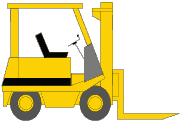Staging and shipping
In most unit load handling environments, the counterbalanced forklift can perform all of these
tasks reasonably well. Specially designed attachments even permit handling of awkward items like coil steel rolls
without the lift truck's usual partner, the pallet.
This multitask flexibility is of most value to the majority of warehouse operations, that is,
those which work in a small-sized warehouse. As warehouses get larger, however, with attendant need for more mobile
equipment, there are good paybacks in increased specialization for part of the fleet.
Because its collapsed mast height must permit lift truck entry into over-the-road transport vehicles,
counterbalanced truck operations are limited to warehouse clear heights of less than 30 ft. A wide range of industrial
truck types can operate in a narrower aisle than those commonly worked by a counterbalanced truck (even when one
includes 3-wheelers), but again these narrow-aisle vehicles are often less efficient in a loading dock environment.
As warehouse volumes change to a full case orderpicking environment, the limitations of the traditional
sit-down counterbalanced truck increase. Within this environment, it can still perform four out of five of the
traditional warehouse functions reasonably well. However, the fifth function - orderpicking - is the most labor
intensive task in most warehouse operations.
If conditions make ground level picking feasible, the commonly substituted walkie rider has its
own attraction. As long as pallets do not have to be elevated, use of the walkie rider is cheaper; and end ride
models can also be used for loading dock operations. There is little argument with these values, but they are generally
limited to within the four walls of a warehouse.
In a broader arena, most warehouse operators tend to forget their dependence on a concrete floor.
Take this factor away - as is common in most outside yard operations - and the counterbalance truck's versatility
again shines. The variety of engine types and fueling options available to the counterbalanced truck operator is
an important advantage here.
Probably one of the biggest failings of the counterbalanced truck is that it isn't glamorous
or sexy. Maybe it's time to recognize some of these traditional values from the old warehouse workhorse.
 FORKLIFT OPERATION AND SERVICE.
BE SURE TO VISIT THE HOME PAGE FOR INFORMATION ON LIFT TRUCKS REPAIR, SERVICE, TROUBLESHOOTING,
AND EVERYTHING YOU NEED TO KNOW ABOUT FORKLIFTS AND THEIR USE.
FORKLIFT OPERATION AND SERVICE.
BE SURE TO VISIT THE HOME PAGE FOR INFORMATION ON LIFT TRUCKS REPAIR, SERVICE, TROUBLESHOOTING,
AND EVERYTHING YOU NEED TO KNOW ABOUT FORKLIFTS AND THEIR USE.



